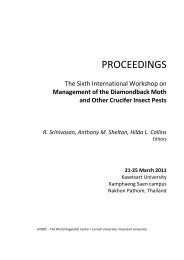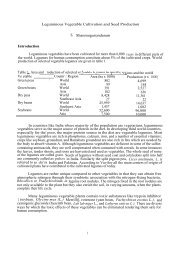Tobacco Mosaic Virus and Tomato Mosaic Virus on Pepper
Tobacco Mosaic Virus and Tomato Mosaic Virus on Pepper
Tobacco Mosaic Virus and Tomato Mosaic Virus on Pepper
You also want an ePaper? Increase the reach of your titles
YUMPU automatically turns print PDFs into web optimized ePapers that Google loves.
<strong>Pepper</strong> Diseases<br />
<str<strong>on</strong>g>Tobacco</str<strong>on</strong>g> <str<strong>on</strong>g>Mosaic</str<strong>on</strong>g> <str<strong>on</strong>g>Virus</str<strong>on</strong>g><br />
<str<strong>on</strong>g>Tomato</str<strong>on</strong>g> <str<strong>on</strong>g>Mosaic</str<strong>on</strong>g> <str<strong>on</strong>g>Virus</str<strong>on</strong>g><br />
Mechanically Transmitted Tobamoviruses<br />
Found worldwide<br />
Symptoms<br />
<str<strong>on</strong>g>Tobacco</str<strong>on</strong>g> mosaic virus (TMV) <str<strong>on</strong>g>and</str<strong>on</strong>g> tomato mosaic virus<br />
(ToMV) are very closely related. TMV has a wider host<br />
range, but occurs much less frequently in tomato than<br />
in tobacco. Both viruses infect pepper, tomato, potato,<br />
<str<strong>on</strong>g>and</str<strong>on</strong>g> several other hosts including weeds.<br />
All growth stages can be affected. Symptoms can<br />
include necrosis <strong>on</strong> any plant part, defoliati<strong>on</strong>, <str<strong>on</strong>g>and</str<strong>on</strong>g>/or<br />
mosaic symptoms <strong>on</strong> leaves, stems, <str<strong>on</strong>g>and</str<strong>on</strong>g> fruit.<br />
Generally, infected plants have a chlorotic mosaic with<br />
distorti<strong>on</strong> of younger leaves, <str<strong>on</strong>g>and</str<strong>on</strong>g> stunting. Severely<br />
affected leaves are distorted or they may have a necrosis<br />
al<strong>on</strong>g the main veins accompanied by wilting <str<strong>on</strong>g>and</str<strong>on</strong>g> leaf<br />
World Vegetable Center<br />
drop. Affected fruit is small <str<strong>on</strong>g>and</str<strong>on</strong>g> may be disfigured with<br />
chlorotic or necrotic areas. Fruit set may be severely<br />
reduced in affected plants.<br />
On chili pepper, comm<strong>on</strong> symptoms are raised<br />
bumps <str<strong>on</strong>g>and</str<strong>on</strong>g> mottled areas of light <str<strong>on</strong>g>and</str<strong>on</strong>g> dark green <strong>on</strong><br />
the foliage, with fruit that ripens unevenly <str<strong>on</strong>g>and</str<strong>on</strong>g> is reduced<br />
in size.<br />
C<strong>on</strong>diti<strong>on</strong>s for Disease Development<br />
Both viruses are seed-borne. Only a few seedlings need<br />
to be infected for the virus to spread rapidly. This rapid<br />
spread within crops is largely due to mechanical<br />
How to Identify <str<strong>on</strong>g>Tobacco</str<strong>on</strong>g> <str<strong>on</strong>g>Mosaic</str<strong>on</strong>g> <str<strong>on</strong>g>Virus</str<strong>on</strong>g> <str<strong>on</strong>g>and</str<strong>on</strong>g> <str<strong>on</strong>g>Tomato</str<strong>on</strong>g> <str<strong>on</strong>g>Mosaic</str<strong>on</strong>g> <str<strong>on</strong>g>Virus</str<strong>on</strong>g><br />
<str<strong>on</strong>g>Mosaic</str<strong>on</strong>g>, stunting, <str<strong>on</strong>g>and</str<strong>on</strong>g> systemic chlorosis<br />
Leaf distorti<strong>on</strong> <str<strong>on</strong>g>and</str<strong>on</strong>g> chlorosis<br />
Written by Ray Cerkauskas, Visiting Scientist from Agriculture <str<strong>on</strong>g>and</str<strong>on</strong>g> Agri-Food Canada. Edited by Tom Kalb. Photos by S.K. Green, L.L.<br />
Black <str<strong>on</strong>g>and</str<strong>on</strong>g> T.A. Zitter. Published by AVRDC – The World Vegetable Center; P.O. Box 42, Shanhua; Taiwan 741; ROC<br />
tel: (886-6) 583-7801; fax: (886-6) 583-0009; email: avrdcbox@avrdc.org; www: www.avrdc.org
transmissi<strong>on</strong> of the virus by workers <strong>on</strong> c<strong>on</strong>taminated<br />
h<str<strong>on</strong>g>and</str<strong>on</strong>g>s, clothing, <str<strong>on</strong>g>and</str<strong>on</strong>g> tools during routine operati<strong>on</strong>s<br />
such as transplanting, tying, pruning, grafting,<br />
cultivating, spraying, watering, picking.<br />
Other sources of the virus include infected weed<br />
species <str<strong>on</strong>g>and</str<strong>on</strong>g> irrigati<strong>on</strong> water. Sec<strong>on</strong>dary spread of both<br />
viruses is by insects such as grasshoppers, small<br />
mammals, <str<strong>on</strong>g>and</str<strong>on</strong>g> birds. <str<strong>on</strong>g>Tobacco</str<strong>on</strong>g> products used for<br />
smoking <str<strong>on</strong>g>and</str<strong>on</strong>g> TMV-infected tobacco plants are another<br />
source of the virus.<br />
The virus is quite stable under adverse envir<strong>on</strong>mental<br />
c<strong>on</strong>diti<strong>on</strong>s <str<strong>on</strong>g>and</str<strong>on</strong>g> can persist in plant debris in dry soil for<br />
2 years or in moist soil for 1 m<strong>on</strong>th or in root debris in<br />
fallow soil for 22 m<strong>on</strong>ths. It can also persist in<br />
greenhouse structures for l<strong>on</strong>g periods of time.<br />
Healthy seedlings planted in c<strong>on</strong>taminated soil can<br />
be infected through minor wounds caused by natural<br />
mechanical damage to roots. Mechanically damaged<br />
roots can be infected by c<strong>on</strong>taminated re-circulating<br />
fluid used for crops grown in hydrop<strong>on</strong>ic systems.<br />
C<strong>on</strong>trol<br />
C<strong>on</strong>sult with your extensi<strong>on</strong> agent regarding infecti<strong>on</strong><br />
by TMV or ToMV since other plant viruses may cause<br />
similar symptoms. Resistant varieties are available.<br />
Check with your extensi<strong>on</strong> agent for resistant cultivars<br />
that are available in your regi<strong>on</strong>.<br />
Use seed from healthy plants <strong>on</strong>ly. TMV or ToMV<br />
<strong>on</strong> the seed coat can be eliminated by soaking seed<br />
for 20 min in 15% of tri-sodium phosphate soluti<strong>on</strong> (TSP)<br />
or 2 hr in 10% of the same material, then rinsing<br />
thoroughly, <str<strong>on</strong>g>and</str<strong>on</strong>g> spreading seeds out to dry. Do not rec<strong>on</strong>taminate<br />
seed by placing them in used c<strong>on</strong>tainers.<br />
Use a minimum 2-year rotati<strong>on</strong>. Avoid following<br />
pepper crops with susceptible crops such as tomato,<br />
potato, tobacco, eggplant, or cucurbits. Keep<br />
producti<strong>on</strong> areas <str<strong>on</strong>g>and</str<strong>on</strong>g> seedbeds free of weeds <str<strong>on</strong>g>and</str<strong>on</strong>g> other<br />
plants that can serve as hosts for the virus.<br />
Locate seedbeds <str<strong>on</strong>g>and</str<strong>on</strong>g> nurseries far away from<br />
tobacco plants <str<strong>on</strong>g>and</str<strong>on</strong>g> storage warehouses. If growing<br />
seedlings <str<strong>on</strong>g>and</str<strong>on</strong>g> transplants in a greenhouse, then use<br />
steam-pasteurized soil in which plant debris has been<br />
allowed to thoroughly decompose since ToMV or TMV<br />
may be protected in thick pieces of root <str<strong>on</strong>g>and</str<strong>on</strong>g> stem<br />
refuse.<br />
Avoid touching or h<str<strong>on</strong>g>and</str<strong>on</strong>g>ling pepper plants prior to<br />
setting them in the field. Avoid h<str<strong>on</strong>g>and</str<strong>on</strong>g>ling other<br />
solanaceous plants prior to h<str<strong>on</strong>g>and</str<strong>on</strong>g>ling pepper plants.<br />
Remove diseased seedlings that show leaf twisting,<br />
mosaic or unusual growth. Remove <strong>on</strong>e or two plants<br />
adjacent to those plants that show symptoms. Do not<br />
touch other seedlings while discarding them.<br />
Dip h<str<strong>on</strong>g>and</str<strong>on</strong>g>s in milk while h<str<strong>on</strong>g>and</str<strong>on</strong>g>ling plants every 5<br />
minutes (more often if different lots of plants are<br />
h<str<strong>on</strong>g>and</str<strong>on</strong>g>led). Rubber gloves will protect h<str<strong>on</strong>g>and</str<strong>on</strong>g>s. Do not clip<br />
or damage young seedlings since this increases the<br />
possibility of mechanical transmissi<strong>on</strong> of the virus from<br />
c<strong>on</strong>taminated tools or h<str<strong>on</strong>g>and</str<strong>on</strong>g>s.<br />
Remove diseased plants from the field as so<strong>on</strong> as<br />
virus symptoms are noticed. This will reduce the spread<br />
of the virus by direct c<strong>on</strong>tact between plants.<br />
Disinfect tools, stakes, <str<strong>on</strong>g>and</str<strong>on</strong>g> equipment before moving<br />
from diseased areas to healthy areas. This can be d<strong>on</strong>e<br />
by: 1) soaking 10 minutes in a 1:10 diluti<strong>on</strong> of a 5.25%<br />
sodium hypochlorite, do not rinse; or 2) by washing<br />
(enough to clean) in detergent at the c<strong>on</strong>centrati<strong>on</strong>s<br />
recommended for washing clothes or dishes. Keep all<br />
soluti<strong>on</strong>s fresh.<br />
H<str<strong>on</strong>g>and</str<strong>on</strong>g>s <str<strong>on</strong>g>and</str<strong>on</strong>g> tools may be washed with soap or milk.<br />
Work in diseased areas last, after working in unaffected<br />
parts of a field. Wash clothing that comes into c<strong>on</strong>tact<br />
with ToMV/TMV-infected plants with hot water <str<strong>on</strong>g>and</str<strong>on</strong>g> a<br />
detergent.<br />
For more informati<strong>on</strong> <strong>on</strong> the producti<strong>on</strong> of<br />
pepper <str<strong>on</strong>g>and</str<strong>on</strong>g> other vegetables, go to<br />
.<br />
AVRDC Publicati<strong>on</strong> 04-594<br />
2004
















